Are you unsure if your little one is ready for the transition to crib? Maybe your baby is close to outgrowing the bassinet but feels not ready for the crib yet? In this article I’m going to share my tips what to do in this situation. Spoiler alert: it’s never too early for the crib!
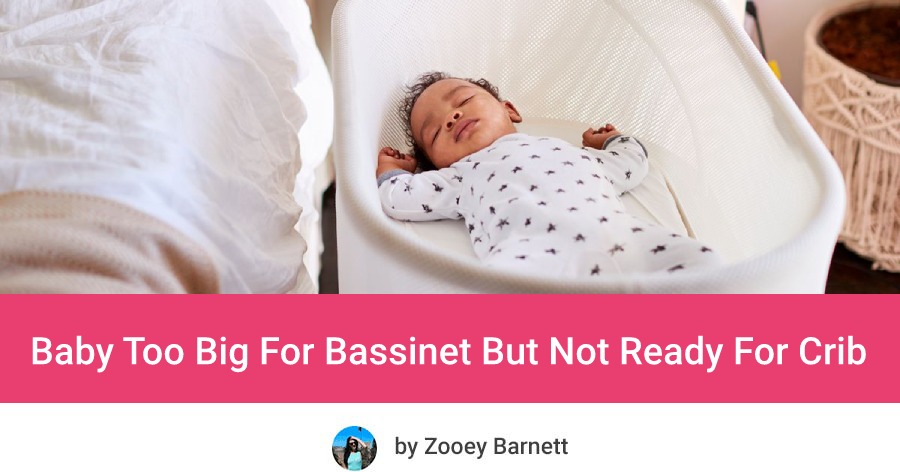
Many parents choose to use a bassinet during the first months with their newborn, and for good reason! Often, newborn babies sleep better in cozy bedside bassinets than they would in a regular crib. Bassinets are sweet, and some are mobile to move to different rooms for naptime, too.
It is recommended that newborn babies sleep in the same room as their parents (but in their own sleeping space) for the first 6 months of life. If the parents room is small, traditional bassinets are a good option because they don’t take up as much room as a crib.
However, as your newborn grows, you may be wondering about the day when your needs more space. Do you buy a bigger bassinet? At what age should infants sleep in a crib? What if they aren’t ready for their own room?
If your baby is sleeping really well in the bassinet but you realize they need more space, this post is all about safe sleeping options once they are too big for bassinet, plus my personal tips and tricks to make the transition to crib easier and less stressful!
This article is not a substitute for medical advice or consultation.
No Such Thing As “Not Ready For The Crib”
To begin with, there is no such thing as “not ready for the crib”. According to the American Academy of Pediatrics, newborns can actually sleep in a crib from birth. You just need to choose one that is approved by Consumer Product Safety Commission (CPSC)1.
Cribs are considered a safe sleeping space, as long as they have a firm mattress and no blankets, beddings, bumpers or stuffed animals inside.
Now, parents might be more comfortable with their newborn baby in a bedside bassinet in the first few months (instead of a crib), to keep the child close to them at night but that doesn’t mean baby is not ready for the crib.
Although there is no such thing as “not ready for the crib”, there is definitely a time when baby outgrows the bassinet.
Safe Sleep Guidelines
If you’re just starting your motherhood journey and want to know more, I recommend you to check out some excellent resources that I’m sharing at the end of this article.
Now, let’s answer the most important question: How do you know when your little one should move from a bassinet into a bigger space?
There are specific milestones to pay attention to:
- Baby is rolling over;
- Your child can pull up on the sides or push on their knees;
- Your child is uncomfortable in a bassinet because there is not enough space;
- Your baby has reached the weight limit of the bassinet.
Transitioning Out Of The Bassinet
Baby sleep is such a delicate thing. If you’ve got a good rhythm and are enjoying restful nights, you may be hesitant to do any changes because of how it might affect your child’s nights.
That’s understandable. The reality is, the first few nights in a new crib might be a challenge, and your child might wake up crying more than usual. Read on for some things I recommend that can help.
Remember: transition to crib is not sleep training. You certainly can use some approaches if you find them helpful, but you don’t have to.
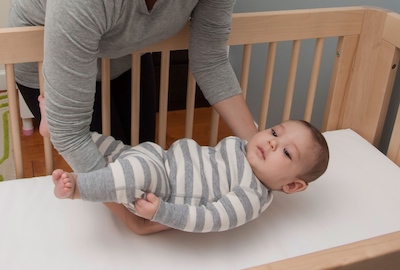
When Do Babies Outgrow Bassinet – Important Signs
If you’re wondering “Is my baby too big for the bassinet?” here are 4 important signs that they have outgrown their bassinet:
Baby Outgrows Bassinet – Weight Limit
Another way to know when to stop using the bassinet is when your baby has reached the recommended weight limit. Not all bassinets have the same weight limits, they can range from 15 lbs – 40 lbs.
The exact weight limit really depends on your specific bassinet so check the manufacturer’s recommendations and stop using the bassinet before they exceed the listed weight.
Baby Outgrows Bassinet – Size/Length
Another sure sign that your baby too big for the bassinet is if baby’s head and feet or legs are close to the bassinet walls, perhaps even brushing against them.
It seems obvious, but actual growing is one way babies can outgrow a bassinet.
Some bassinets list size limits as well as weight limits, so confirm if your baby’s length is creeping in on the maximum length of the bassinet, or just visibly look to see if your baby too big and needs more space.
Movement Milestones: Your Baby Has Started Rolling Over
It’s not all about size, though. One of the important milestones that also means that your baby is too big for the bassinet is if they can roll over.
Rolling over in a bassinet can be dangerous – your baby could get wedged against the cloth side and the thin bassinet mattress. In such cases, baby’s safety is at risk, Your baby can pull or sit up on their own
Movement Milestones: Baby Can Sit Up
Another milestone to pay attention to is if your baby can sit up (or even start to pull up) on their own.
While most babies will begin rolling over before sitting, it is a possibility that your baby will surprise you by try to grab the bassinet wall and pulling up earlier than you’d imagine.
If your infant starts to pushing on their arms and knees, it also the sign it’s time to switch the bassinet for a crib.
What Age Is Too Big For A Bassinet?
Remember, it’s not about age here, but rather baby’s bassinet weight limit, baby’s size and if they can roll over on their own.
However, lots of parents are wondering how long do babies usually use the bassinet. The answer is: typically, babies will outgrow their bassinets between 4-6 months of age, as they grown and reach the milestones listed above.
What Do You Do When Baby Is Too Big For Bassinet?
When your baby has officially outgrown their bassinet, it is time to transition them to another safe sleeping space that has more room.
What Should Baby Sleep In After Outgrowing Bassinet?
You have basically 3 options: full-size crib, mini crib or pack-n-play. Choosing the right one will depend on how much free space you have at your home and if you need something portable.
1. Regular Crib
Standard crib is a great long-term solution. Some cribs are convertible to toddler beds, day time bed and even twin size beds, so you can use one for several years – something you cannot do with a bassinet.
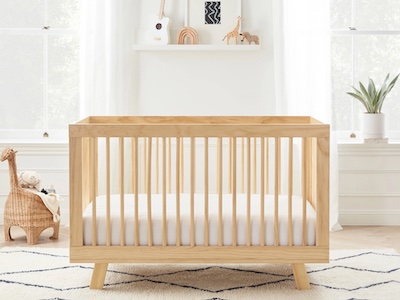
What To Keep In Mind About Cribs
If you’re a petite mama, check out my post about best cribs for short moms. Other useful resource: how to stop baby from chewing on crib rails.
2. Mini Crib
If nursery or bedroom space is the question, you could consider getting a mini crib. It has all the benefits to a crib, without making your space feel cramped (read my list of the best mini crib for small spaces).
Most mini cribs are around 24″x 38″ (which is as much as 14 inches shorter than a full-size crib).

What Keep In Mind About Mini Cribs
Because it is smaller, you won’t get as much use out of it as a regular, standard-sized crib. Expect your baby to move up to a toddler bed around the age of 18 months.
Pack-N-Play
Also known as a playpen, what I love about this option is that it’s easy to position it next to your bed, just like a bassinet.
A playpen makes for a great portable bed, too, take it camping, on road trips, or use when you need to keep your crawling baby contained so you can prepare dinner.
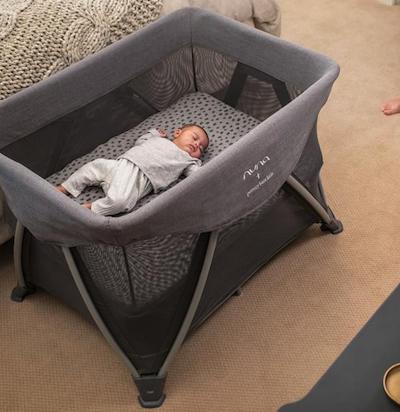
What To Keep In Mind About Pack N Plays
The mattresses that are included are very firm, and some parents are worried that it’s not a comfortable sleeping space for the infant. No need to worry! Thin and firm mattress is safe for the baby and you don’t have to do anything to make pack n play more comfortable. It is not safe to add another mattress to a pack-n-play.
How To Transition From Bassinet To Crib
When it’s time to transition your baby to crib, think “slow and steady”. This transition can span weeks, if your child needs that to adjust.
1. Choose the right sleeping space
If you’ve decided on a crib – great! ensure you have the appropriate fitting, good mattress and bedding (no loose bedding, sheets should be tight)
2. Don’t put suffocation hazards in the sleeping area
Read the above resources for what NOT to include in baby’s bed (i.e. no pillows or soft toys.)
3. Always put baby “back to sleep”
The back is the safest sleeping position for an infant.
4. Check the room
Temperature and lighting matter! Babies typically sleep best between 68-72°F. Use black-out curtains, if necessary.
5. Feed and burp
Make sure baby has been well-fed and burped before lying them down.
6. Spend more time in the nursery over the days and weeks of transitioning
Nurse or rock them in a comfortable chair in baby’s room. Change their clothes and do baby massages after bath time in the nursery, too
7. Don’t stress if baby cries (especially the first night)
Remember crying is a form of communication for infants, it does not necessarily mean they are in pain or scared- they could simply be uncomfortable.
While it is healthy and good for you as a mom to attend to your child’s needs when he cries, it’s also okay to have a 10 or 20 second pause before going in.
8. Don’t pick up immediately
Try rubbing your fussy baby’s back first – if she’s still dozing, this might be enough to soothe her. If she still won’t calm down, then pick her up and comfort her.
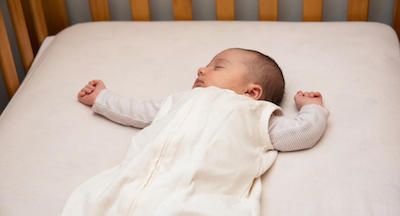
7 Tips What To Do If Baby Is Too Big For Bassinet But Not Ready For Crib
I know that swapping bassinet for crib can be quite stressful, for both the baby and parents, so here are a few tips and tricks to make the transition to crib easier (I have personally tried them with my children).
- Use crib for naps at first
A great way to help your little one adjust to sleeping in the crib is to use it during naps, at first. This way, it becomes a more familiar sleeping environment, making it easier when you do make the switch.
- Keep the crib in your bedroom
The American Academy of Pediatrics recommend babies sleep in the same room with you for the first 6 months of life.
Basically: if you can fit a crib in your bedroom – do it! This makes the transition from bassinets to cribs (especially if mom is breastfeeding) to a crib during nighttime a lot smoother. Move baby to the nursery when you both feel ready.
- Set (and stick to!) a bedtime routine
Babies tend to sleep better when they have a set routine, especially for overnights. Set up a good night schedule, with bath time, lullabies, a feed and dim lights to help them settle.
| PRO TIP: Try using a safe and natural baby oil for massage after baby’s bath, to encourage relaxation and a deeper slumber. |
- Use a video monitor
If your child is sleeping in the nursery, set up a video monitor.
This will give you peace of mind (instead of physically checking 5x a night), and will reduce your accidentally waking them if you hear the tiniest noise from their nursery and go running to check.
- Make your nursery as dark as your bedroom
If your child is in a separate room, then try to make the room just as dark as your bedroom so it feels the same.
- Have your baby wear a sleepsack
If your child is rolling over, then you should have stopped swaddling. Likewise, if your baby too big for the bassinet, it is likely they have outgrown the swaddle, too.
Sleeping sacks are the next step. They are a good way to help keep your little one cozy and warm, without the suffocation risk, like normal loose blankets. They also help prevent baby from waking up if they move, because the legs are inside the sack.
What’s interesting it is safe for the baby to use the sleeping sack even during summer.
On the market there are also awesome sleep bags for toddlers that are designed for kiddos who can already stand up and even walk.
- Put a sweater over a chair next to the crib
Here’s my final hack: position a chair near the crib and drape one of your sweaters over it. Your child should not be able to reach the sweater or pull it off the chair.
So what’s the point? Your scent, Mama.
Sometimes the most comforting thing is having mother’s scent, and a sweater you recently wore provides just that. They will think you are next to them and sleep better.
The purpose of this article is informative. It’s not a substitute for professional medical advice or medical care. Remember: safety first! Consult your doctor/pediatrician in case of any doubts. The author of this article does not accept any responsibility for any liability, loss or risk, personal or otherwise, incurred as a consequence, directly or indirectly, from any information or advice contained here.
Resources:
A Parent’s Guide to Safe Sleep
Healthy Children.org: Safe Sleep and What to Avoid
American Academy of Pediatrics: Evidence-Base 2022 Recommendations
American Academy of Pediatrics: Sleep-Related Infant Deaths
Pictures of crib and mini crib belong to Babyletto. Source: https://babyletto.com/
Picture of pack-n-play belong to Nuna. Source: https://nunababy.com/usa

